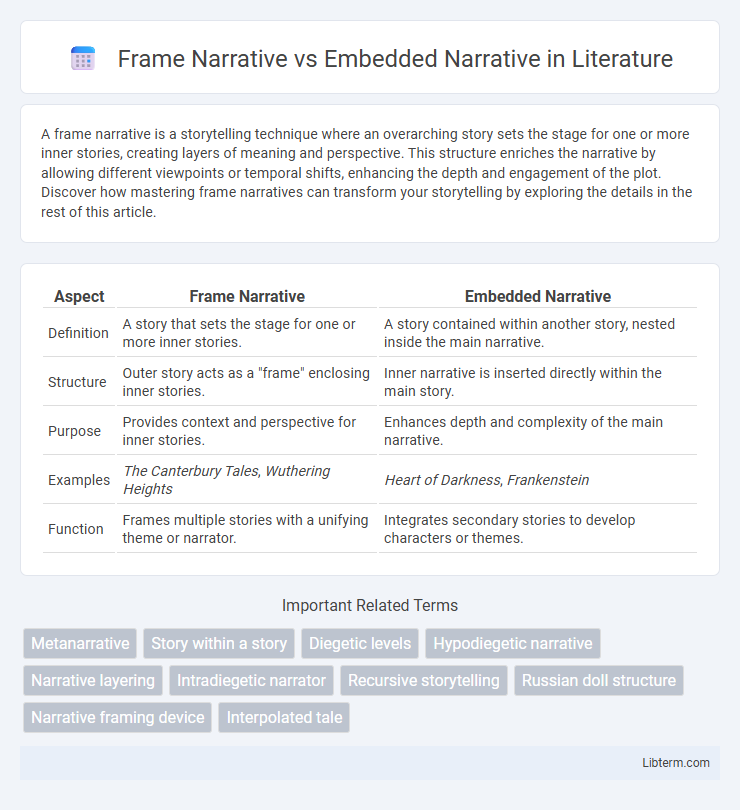A frame narrative is a storytelling technique where an overarching story sets the stage for one or more inner stories, creating layers of meaning and perspective. This structure enriches the narrative by allowing different viewpoints or temporal shifts, enhancing the depth and engagement of the plot. Discover how mastering frame narratives can transform your storytelling by exploring the details in the rest of this article.
Table of Comparison
| Aspect | Frame Narrative | Embedded Narrative |
|---|---|---|
| Definition | A story that sets the stage for one or more inner stories. | A story contained within another story, nested inside the main narrative. |
| Structure | Outer story acts as a "frame" enclosing inner stories. | Inner narrative is inserted directly within the main story. |
| Purpose | Provides context and perspective for inner stories. | Enhances depth and complexity of the main narrative. |
| Examples | The Canterbury Tales, Wuthering Heights | Heart of Darkness, Frankenstein |
| Function | Frames multiple stories with a unifying theme or narrator. | Integrates secondary stories to develop characters or themes. |
Introduction to Narrative Structures
Frame narrative, also known as a story within a story, introduces an overarching story that sets the context for one or more embedded narratives. Embedded narratives are self-contained stories inserted within the main story, often providing background or different perspectives related to the frame. These narrative structures enhance complexity and depth by layering multiple storylines, allowing authors to explore themes and character development from varied angles.
Defining Frame Narrative
A frame narrative is a literary technique that features a main story enclosing one or more secondary stories, providing context or background for the embedded tales. This structure allows authors to create layers of storytelling, often enhancing themes and character development by linking different narratives. It serves as a framework that guides readers through complex plots by establishing a clear starting and ending point around the inner stories.
Understanding Embedded Narrative
Embedded narrative is a story within a story technique where an inner tale is inserted into the main narrative framework, enriching the overall plot and providing different perspectives. This literary device enhances thematic depth and character development by allowing multiple viewpoints and timelines to coexist, often revealing critical background information or motivations. Understanding embedded narrative involves recognizing how the inner story influences the outer narrative's meaning and emotional impact by creating layers of storytelling.
Key Differences Between Frame and Embedded Narrative
Frame narrative structures a main story that sets the context for one or more embedded narratives, which are stories told within the main story. Embedded narratives are contained within the frame and serve to elaborate, illustrate, or complement the overarching narrative, often providing different perspectives or background information. The key difference lies in their function: the frame narrative acts as a container and context provider, while embedded narratives are enclosed stories that deepen the plot or enrich the thematic development.
Historical Evolution of Frame Narratives
Frame narratives originated in ancient literature, with early examples such as "The Tale of the Shipwrecked Sailor" and "One Thousand and One Nights," serving as structural devices to organize stories within a cohesive context. The technique evolved through medieval and Renaissance periods, prominently featured in works like Boccaccio's "Decameron" and Chaucer's "Canterbury Tales," where embedded narratives allowed exploration of diverse perspectives within a single frame. This historical evolution highlights how frame narratives functioned both as storytelling methods and as literary tools to reflect cultural and social complexities across different eras.
Famous Examples of Frame Narratives in Literature
Frame narratives structure a story within another story, creating layers of meaning and perspective, as seen in Mary Shelley's *Frankenstein*, where Captain Walton recounts Victor Frankenstein's tale. Another famous example is Geoffrey Chaucer's *The Canterbury Tales*, which presents a series of stories told by pilgrims during their journey, offering diverse viewpoints and thematic richness. This technique enhances narrative depth by embedding multiple voices and experiences within a single literary work.
Notable Uses of Embedded Narratives
Notable uses of embedded narratives appear prominently in classic literature, such as Mary Shelley's "Frankenstein," where the story unfolds through multiple layers of storytelling by characters within the main plot. In film, embeds within movies like "The Princess Bride" offer a story-within-a-story format that enriches the main narrative with depth and varying perspectives. Interactive media and video games increasingly employ embedded narratives to enhance user engagement by providing background stories accessible through character interactions or environmental storytelling.
Narrative Effects: Impact on Reader Engagement
Frame narratives create a structured context that enhances reader engagement by providing a clear perspective through which the embedded story is interpreted, fostering deeper emotional connection and suspense. Embedded narratives add layers of complexity, encouraging readers to actively piece together multiple plotlines and perspectives, which heightens cognitive involvement and curiosity. This dual narrative approach often results in increased immersion, as readers navigate between different temporal or spatial frameworks, enriching their overall understanding and investment in the story.
Choosing the Right Narrative Structure for Your Story
Selecting between a frame narrative and an embedded narrative depends on the complexity and layering desired in the story. Frame narratives provide a structural overview that contextualizes the embedded tale, enhancing themes through juxtaposition, while embedded narratives allow deeper exploration of individual perspectives within the overarching framework. Writers should assess whether their story benefits from a broad contextual lens or an intimate, nested viewpoint to optimize reader engagement and thematic depth.
Conclusion: The Significance of Narrative Levels
Understanding the distinction between frame narrative and embedded narrative reveals the complexity of storytelling structures and their impact on reader engagement. Frame narratives create a broader context that shapes the interpretation of embedded stories, enriching the thematic depth and adding layers of meaning. This multi-level narrative approach enhances the overall coherence and invites readers to explore different perspectives within a unified plot framework.
Frame Narrative Infographic

 libterm.com
libterm.com